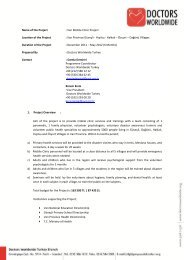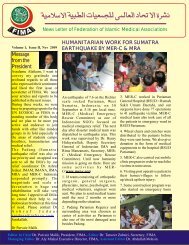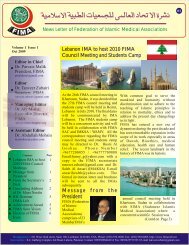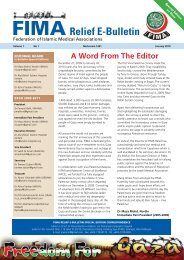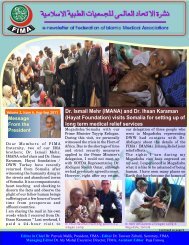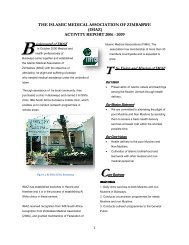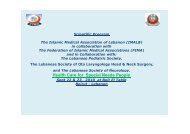FIMA Year Book 2010-2011 - Federation of Islamic Medical ...
FIMA Year Book 2010-2011 - Federation of Islamic Medical ...
FIMA Year Book 2010-2011 - Federation of Islamic Medical ...
You also want an ePaper? Increase the reach of your titles
YUMPU automatically turns print PDFs into web optimized ePapers that Google loves.
COLLABORATIVE MODEL<br />
To date, three eye hospitals have been established,<br />
one each in Africa, South Asia and South East<br />
Asia.<br />
This paper focuses on the Sudanese experience at<br />
al-Genaina, Darfur, West, Sudan as a case<br />
example for the model and its unique approach.<br />
West Darfur is one <strong>of</strong> the three parts <strong>of</strong> Darfur<br />
province <strong>of</strong> Sudan. al-Genaina is the capital and<br />
major city. The western porous borders <strong>of</strong> this<br />
province is with the Republic <strong>of</strong> Chad. This area<br />
has been under social conflict for centuries, and<br />
has been in a state <strong>of</strong> civil war since 2004. This<br />
situation deprived the area from all sorts <strong>of</strong><br />
developmental activities. Health is the most<br />
neglected area, and eye care facilities were totally<br />
non-existent till the year 2006.<br />
All types <strong>of</strong> chronic eye diseases were prevalent,<br />
among which cataract was dominating. Huge<br />
backlog <strong>of</strong> bilateral blinds due to cataract were<br />
waiting in this area.<br />
Sudan as a whole is deficient in eye surgeons but<br />
this area was totally deprived <strong>of</strong> any eye surgeon.<br />
The population <strong>of</strong> Sudan according to population<br />
statistics <strong>of</strong> 2003 is approximately 37 million, with<br />
an annual growth rate <strong>of</strong> 2.6%. 3<br />
Darfur West has a population <strong>of</strong> around two<br />
million. Out <strong>of</strong> these 30,000 are estimated to be<br />
blind, with an estimated minimum <strong>of</strong> 18,000 cases<br />
<strong>of</strong> cataract.<br />
Cataract, as a leading cause <strong>of</strong> blindness around<br />
the globe, holds true for Sudan as well. It is<br />
estimated that cataract represents 60% out <strong>of</strong> all<br />
cases <strong>of</strong> blindness there. Irrespective <strong>of</strong> its type,<br />
cataract is present in all regions <strong>of</strong> Sudan. The<br />
Backlog <strong>of</strong> cataract cases in the country is<br />
estimated to be around 350,000. 4<br />
Cataract surgical rate (CSR) in Sudan was 830 in<br />
2004. 4 Sudan aims to achieve a CSR <strong>of</strong> 2500 by<br />
the year <strong>2010</strong>. 4 The target, though not that high,<br />
might be quite difficult to achieve given the<br />
problems and constraints the Sudanese Eye Care<br />
System is having. The core problems and<br />
constraints <strong>of</strong> the Sudanese eye care system may<br />
be summarized as follows:<br />
- Weak infrastructure, particularly in the area<br />
<strong>of</strong> eye care.<br />
- Few qualified and skilled human resources<br />
(HR) for eye care.<br />
- Mal-distribution <strong>of</strong> the available HR.<br />
Sudan, in 2003, had only 160 ophthalmologists -<br />
<strong>of</strong> whom 110 were deployed in the capital territory<br />
Khartoum- and only 50 were scarcely dispersed in<br />
the remaining parts <strong>of</strong> Sudan. The West Darfur<br />
province was conspicuous by the absence <strong>of</strong> a<br />
single ophthalmologist even as late as 2005. 3<br />
In this backdrop, the Save Vision activities <strong>of</strong><br />
<strong>FIMA</strong> were started in Sudan in the early months<br />
<strong>of</strong> 2005.<br />
Aim:<br />
- To develop a sustainable support system for<br />
prevention <strong>of</strong> blindness, focusing on cataractrelated<br />
blindness, in this resourcesconstrained<br />
Sudanese province.<br />
Strategic Objectives:<br />
- Improving the CSR, and thus reduce the<br />
cataract backlog in the country<br />
- Creating and/or strengthening the eye care<br />
infrastructure in the country<br />
- Capacity building <strong>of</strong> the eye care HR in the<br />
country<br />
Methodology:<br />
The action model for the achievement <strong>of</strong> these<br />
strategic objectives initially started as a<br />
collaborative activity in the form <strong>of</strong> private to<br />
private partnership at the international level, i.e.,<br />
social worker individuals/organizations/welfare<br />
groups in the host country (Sudan) on one hand,<br />
and <strong>FIMA</strong> on the other hand.<br />
Neglected and marginalized locations <strong>of</strong> the<br />
country were preferred over central locations for<br />
the intervention, in deliberate attempt at balancing<br />
the existing care bias towards major cities where<br />
the country’s Eye Care HR is largely concentrated.<br />
<strong>FIMA</strong> <strong>Year</strong><strong>Book</strong> <strong>2010</strong>-<strong>2011</strong> 80




